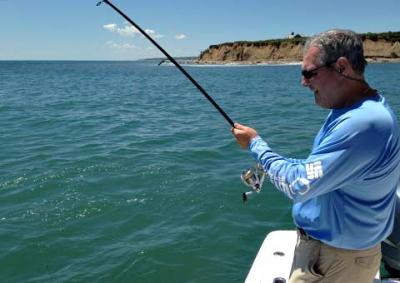A Shiver and a Bloat

A shiver of sand tiger sharks approached the beach from the south in downtown Montauk and a large body of bluefish that were hunting schools of smaller prey concentrated between the sharks and a bloat of boogie boarders.
How about that? A “bloat of boogie boarders” and a “shiver of sharks.” The former description is my invention, and I like it. A “shiver” is actually — and appropriately — the word used to describe a group or school of sharks, much like a murder of crows expresses their gathering.
The scene in the lead paragraph, although not witnessed per se, was probably enacted for real over the weekend. Surfcasters caught a few sand tigers, a.k.a. gray nurse sharks or spotted ragged-toothed sharks, according to Glenn Grothmann at Paulie’s Tackle shop in Montauk.
Not to worry. The sand tiger, Carcharias Taurus, although a cousin to the shivery-ist of all sharks, has never been responsible for a human fatality. They are not related to tiger sharks, which have caused many a human fatality. And, the sand tiger is a protected species. They are gray with reddish-brown spots and can grow to 10 feet long. Grothmann said that at first glance, sand tigers might appear to be small threshers. They have a similar, though shorter, sickle-shaped tail.
There is little question that the sand tigers were in pursuit of bluefish. By all reports, blues are everywhere, some of them very big. This time of year, Capt. Ken Rafferty, a charter captain who specializes in light-spin-tackle and fly fishing, usually moves east from Gardiner’s Bay and the isles of Gull — his usual haunts — to Block Island Sound and around Montauk Point, where light-weight rods have been bowing deeply to the big blues.
We have been blessed by some incredibly beautiful weather as well as a large selection of sea life. In addition to the sand tigers, surfcasters working our sand beaches from Montauk west have been catching fluke on bunker chunks, as well as big porgies and triggerfish.
Triggers are a tropical and subtropical species with vivid colors and intricate patterns on their bodies. They either travel in the warm Gulf Stream water this time of year or time their northern migrations to meet it. It’s not unusual to see colorful tropical reef types this time of year.
To protect themselves from predators, they can erect a formidable dorsal spine located top and forward on their bodies. Fishermen wishing to release them should know that by depressing a second spine, the “trigger spine,” located behind the first, the first more dangerous spine is unlocked.
As for striped bass, most of the activity has been taking place by the light of the moon. A blue moon arrives tomorrow night, “blue” because that’s what you call the second full moon in a calendar month. The first bloomed on July 2. Because striped bass like to hunt by the light of the moon, bass fishermen have become loonier than usual.
And speaking of loony, I wonder if perhaps the East Hampton Town Marine Patrol, the Coast Guard, or the various businesses that rent kayaks and stand-up paddleboards might keep paddlers from meandering around in our navigational channels, especially the Montauk Harbor inlet.
People unaccustomed to our strong tides (and the dangerous condition caused by wind blowing against strong tides) and boat wakes, can find themselves in serious trouble, especially in fog or low-light situations.
They should not assume that big fishing boats and yachts can see them, or, if they do see them, that they are able to stop or navigate around them. I was leaving the harbor last week as a group of five or six kayakers were attempting to exit the inlet in a 15-knot wind, tide racing, in heavy chop with a couple of big party boats entering the harbor. Scary.
Kayaks and the like should not be allowed in navigational channels.
